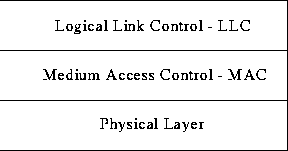
The IEEE Committee has developed a three-layer architecture for local network access as illustrated in Figure 1.
Figure : IEEE Reference Model
The IEEE Committee split the data link layer into two sublayers: Media
Access Control (MAC) and Logical Link Layer (LLC). This sublayer was
implemented to make the LLC sublayer independent of a specific LAN
access method. The LLC also is used to provide an interface into or out
of the specific MAC protocol.
LLC provides the interface to the next upper-layer protocol, which
can be a user application, but more often is a network layer protocol
such as the widely used Internet Protocol (IP). As part of these
interfaces, LLC is responsible for:
The MAC sublayer consists of other sublayers. These sublayers are organized as transmit or receive entities. And finally, at the lowest layer, are the functions generally associated with the physical layer. For more detailed discussion about Link Control Protocols see [Stallings 91] and [Black 93]
From the discussion above it is clear that the MAC/LLC split provides several attractive features:
This approach gives an IEEE LAN architecture a flexible interface with workstations and other networks. It also make the LLC sublayer independent of a specific LAN access method. Note also that a set of modular protocols for each part has the advantage of hiding the details from one sublayer to another, and also makes it easier to understand.